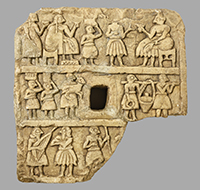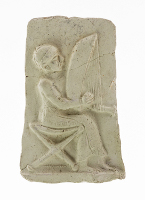Banquet Plaque
The top register of this plaque shows a seated man and woman celebrating an unidentified event or ritual by participating in a banquet. Two servants attend them while others bring a jar (probably filled with beer), an animal to be slaughtered, and other edibles carried in bundles on their heads. Musicians and dancers in the bottom register add to the festivities.
Plaques such as this were part of a door-locking system for important buildings. The plaque was embedded in the doorjamb and a peg, inserted into the central perforation, was used to hold a hook or cord that secured the door and was covered with clay impressed by one or more seals.
Plaque Showing a Harpist
Harps are known from the earliest period of written history, but the fringed robe and close-fitting cap of this harpist are typical for the early second millennium B.C. in Mesopotamia. Clay plaques from this period depict musicians playing a variety of stringed, percussion, and wind instruments. The casting of plaques was a simple and inexpensive way to produce relief images, since numerous plaques could be made from a single mold.



